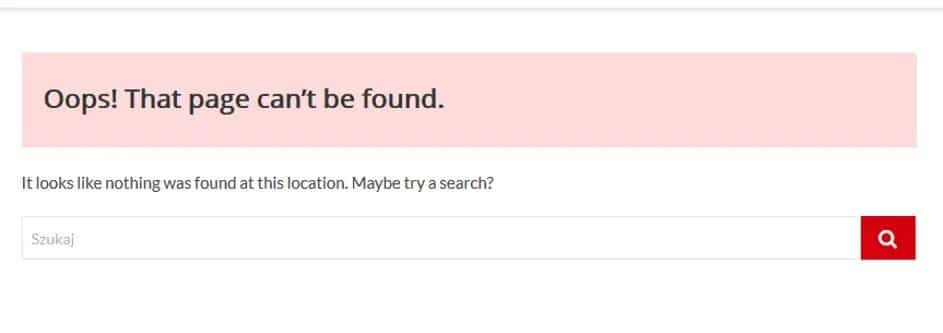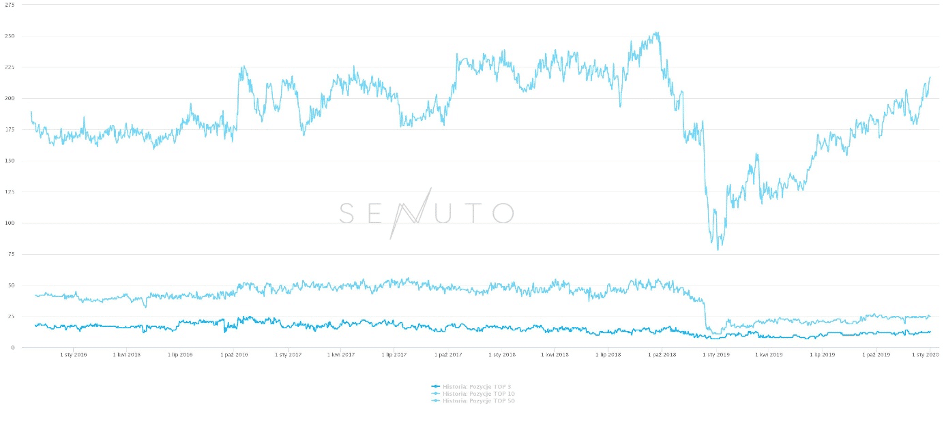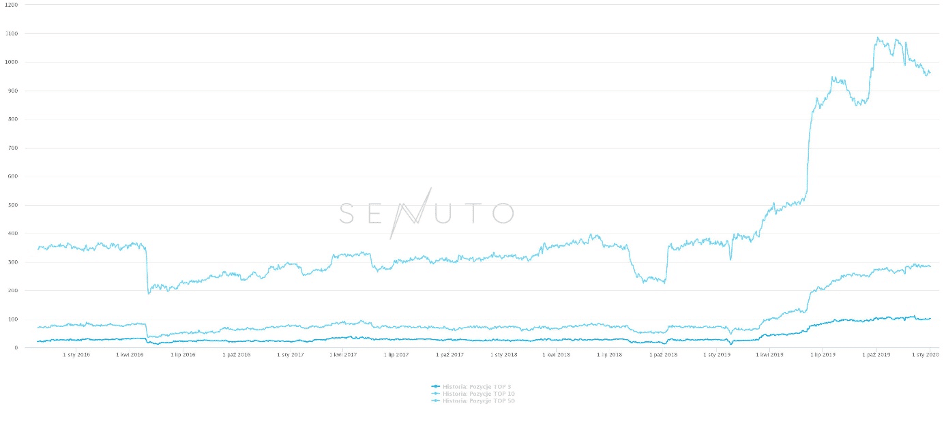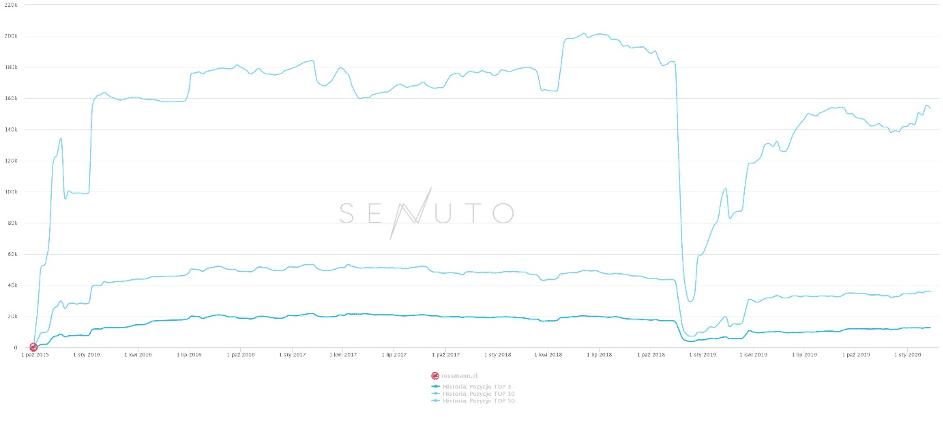A website is the place where we present our offerings to potential customers. How it presents itself affects the perception of our company. Therefore, changing it is a process that offers great opportunities and has a significant impact on the continued operation of the business.It is important to remember, however, that the changes made have a significant impact on the visibility of our website. This is why we suggest how not to mess up SEO the moment we decide to change our website.
Most common reasons for changing a website
.
A new website offers many new opportunities. But often its change is preceded by specific arguments.
Modern design and offerings in a new setting
.
Usually companies decide to change their website due to its outdated appearance. So this is an ideal opportunity to present our offer in a new more convenient way. The same is also true for the content we want to convey to the user. Here, however, great care should be taken not to lose what we have already achieved.
Site speed and high update costs
.
A website should open quickly. Otherwise, many visitors to our site will give up browsing before the site displays all the content. This situation contributes to a loss of traffic and an increase in the rejection rate. In addition, this decreases the competitiveness of our site in the eyes of Google. That’s why it’s worth thinking about the speed of the site from the very beginning of its design, because high-resolution graphics do not always go hand in hand with speed.

Another problem that can then arise are issues related to updating plugins and extensions that have been implemented. A single click can kill a site or cause a series of errors to appear. Another aspect is the danger of outdated plugins being an easy target for hacking the site.
How to go about changing a website and what to look out for?
.
Changing a website is an undertaking that requires proper preparation. It is a process that involves a number of decisions that result in success. Before this happens, the work on the new version of our site is usually carried out in several stages, which include:
Preparing the graphic design of the new website
.
Based on the specified requirements of the client, a graphic creation is prepared that is fully tailored to our needs and visions. Here there is great freedom of solutions to present our offer in a new attractive light. The new layout of the site with a clear layout of the content is a big plus. This applies to all subpages of the site and especially the home page and subpages with the offer.
Design consultation with agency for SEO
.
Creating a new website involves building a solution based on consultations and a series of guidelines. This is also the case with SEO, so at the very beginning of cooperation with a web developer or graphic designer, it is worthwhile to establish important issues concerning the various elements of the site. We are mainly talking about the structure of the site, the number of subpages and the content on them.
Also read: How should an SEO report from an agency look like? .
Implementation of graphic design with recommendations
.
The next step in the creation of a new website is the implementation of the graphic design established earlier. Here, special attention should be paid to how this will be implemented. A good practice is to create a new site on a subdomain or local resource. In the case of a subdomain, it is important to remember the important point of disabling indexing, as this will prevent the indexing robot from visiting the site too early and putting the site into the index.
Verify implementation and ongoing monitoring of changes
.
It is worthwhile to watch over the entire process of work on the site until it is completed. This is an important point to avoid oversights that can backfire on the results the new website gets. Also, don’t forget the ongoing analysis after the work is completed, as important recommendations from Google Search Console may flow down to you.
Recommendations so we don’t mess up SEO on a new website
.
Friendly URLs and redirects
.
The structure of address URLs should be clear. So avoid multi-level nesting, which will make sub-page addresses long and difficult to remember. In addition, do not forget that URLs allow search engines to understand the structure of a website. It is important here to eliminate the generation of a session ID in the URL and modify addresses that do not look natural.
- https://stronainternetowa.pl/oferta
- https://stronainternetowa.pl/oferta/93021745jsjds.html
As the old site ceases to exist, there are old addresses in the search results that direct to non-functioning sub-pages. This is an undesirable situation, in which it is necessary to set up 301 redirects. Each redirect should direct to the appropriate destination sub-page. Only then is a customer visiting our new site able to navigate to a new version of the sub-page, such as Offer or About-us.

Create a site map
.
A site map is an index of all the subpages that exist on our website. It also has a significant impact when further indexing the site, so it is essential to create one and keep it updated.

Number of subpages and content present on them
.
If our existing website had several sub-pages describing the products or services offered, then you should keep them. This will allow for full exhaustion of the topic, which will result in high positions and traffic.
Nevertheless, it is worth being careful, because a common phenomenon when designing the appearance of a new site is to bet on minimalism in terms of the number of subpages and the amount of content. This is an undesirable phenomenon, because short content is not user-friendly and cannot be fully optimized. All because they are not able to accurately convey all the information. Here, the worst-case scenario may be deciding to create a new page on the one page model and duplicating content multiple times within the site (duplicate content).
Quality sub-pages with unique content
.
If you plan to create a classic website with a number of sub-pages, you should pay special attention to the architecture of information. This applies to both the structure of the subpages and the content on them. The subpages on our site should be arranged in a specific structure, which will later find a mapping in the indexing of the site by the robot.
An arranged structure also gives us room to perform proper internal linking. In addition, when creating subpages, it is worth thinking about the meaning of their existence. Such an action will allow us to avoid writing about a topic that no one will search for online. Another important point is that the subpages we create should not be about the same topics. This has a significant impact on the visibility of the site and will avoid the phenomenon of cannibalization of sub-pages for given keywords. Therefore, first of all, you should avoid creating several subpages on the same topic, as this can only harm us.
In a situation where we follow these recommendations, the next step is to prepare content, which also requires following certain rules. We have already said that the amount of content on the subpages plays an important role in the fight for high positions. We should also not forget that volume of content should go hand in hand with quality, which will work in our favor or the other way around.
How the architecture of information is prepared will determine the page positions and traffic. Therefore, when planning content for our new site, let’s not forget who our site is aimed at and what future users may be looking for on it. Only then will we be able to select the right keywords for which our competitors are positioning themselves, among others.
Internal linking
.
Internal linking is one of the important elements to consider when creating an SEO strategy. It is also an important aspect for users and robots to reach from important sub-pages.
Implementation of Google Analytics and Search Console tools
.
Google Analytics and Google Search Console are a must have for any website. So, just before launching the final version of our website, we should implement tracking codes for Google Analytics tools and Google Search Console on the site. These will allow us to collect data from the very start of a new site and allow us to analyze any errors that occur in real time.
Changing a site versus its visibility and positions
.
By applying the above recommendations, we can avoid serious visibility losses. This is especially important because the level we have built up over the years can fall into disrepair. Below is an example of a situation in which 301s were not performed for old addresses after a website change. This resulted in a large drop in visibility for all position ranges in January-February 2019:

Implementing all the recommendations on the new site is a step towards buildinggreater site visibility. As a positive example, another website underwent several medic update updates and recorded record visibility in 2019. In the chart below, you can see the increase in position that took place after the site changed in early 2019:

An infamous case that should serve as a warning to us is the change of the Rossmann.co.uk online store website. This change took place in November 2018 and resulted in a drastic drop in visibility. In the chart below, you can see the gap when the site change occurred.

The reason for such a decline was bad strategy already at the initial stage of the design of the new online store. Its main factor was the use of a new site engine based on content generation using javascript. In this way, the content of the subpages was automatically generated, which is not handled by the Google robot. Therefore, such a situation resulted in the fact that as a result of the lack of standard html language elements in the page code in the form of, among others, paragraphs and headings, Google perceived the new page as empty, which translated into the positions obtained at the time. But these were not all the mistakes that occurred.
Another important mistake was the lack of new counterparts for relevant subpages that were gathering traffic and the lack of redirection configuration. As a result, users from the search engine hit a huge number of 404 errors. Also, the subsequent redirect configuration was improperly done, as the old addresses directed to new pages that were not thematically related at all.
Summary
.
The cases described in the article clearly indicate that changing a website is a process that requires proper preparation from the very beginning of planning the new version of our site. Therefore, in order not to spoil SEO during the change of the site, special attention should be paid to taking into account the mentioned factors during the further stages of its implementation.
Equally important is ongoing analysis and action after the new site is completed. Only if we act diligently on the basis of the above-mentioned guidelines will we avoid the dips and losses that would result from overlooking individual factors that have a significant impact on the visibility of our new site. Let’s not forget that this is especially important because the change of site brings new opportunities. It is also our chance for success, which will be increases in the position and number of visitors to our new website.
 Mariusz Jałyński
Mariusz Jałyński